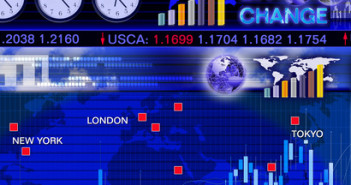It’s not clear that FX markets have found their footing so far in the current quarter. Having seen such a dollar-negative trend in the run-up to the Fed’s QE announcement, the replacement is not yet clear. The dollar itself is now trading above the levels prevailing at the time of the Fed announcement (on DXY dollar index) and as yet, investors are not getting wobbly regarding the ‘fiscal cliff’.
For EUR/USD, the break below and then back above the 200d moving average on Monday, which proved to be a reliable support last week, appears to have dented the markets’ faith in pushing EUR/USD lower. Elsewhere, the Aussie has been buffeted by fresh selling overnight as expectations grow regarding a follow-up rate cut from the RBA next month.
The AUD has fallen back to the 1.02 level, with the low of 1.0165 recorded four weeks ago likely to be tested before too long. Once again, some traders have been aggressive buyers of the EUR/AUD cross, propelling it to a four-month high of 1.2630. In addition, AUD/JPY has fallen through the 80 level after numerous attempts over the past three months – the bears are now frothing over a potential move down to the June low of 74.48. Ahead today we await PMI services readings out of Europe’s major economies, to be followed by America’s version (the ISM non-manufacturing composite) this afternoon. The private payrolls figure released by ADP Employer Services will also provide some colour on the labour market ahead of Friday’s non-farm payrolls figures.
Commentary
What’s underpinning gold? After Monday’s high for the year at USD 1,791.50 the gold bulls are back on the street. But for now, the USD 1,800 barrier is proving to be tough resistance, as was the case back in March when gold was last up near these levels. What we have seen is new record highs for gold in euros at EUR 1,386.51. There are two underlying factors that have been working against each other and capping the gains of the gold price in the past couple of weeks. First, the further fall in interest rates across major markets, with US 10Y yields back towards the 1.60% level, having been above 1.80% mid-September. This has also pushed our measure of global real interest rates (i.e. return after inflation) even further into negative territory at -0.64%. The measure has been negative for nearly all of the year to date and a contributing factor to the rise in the gold price. This has offset the downwind from the reversal of the dollar weakness that was prevailing through most of August and the first half of September. However the real lift for gold, or at least that on which many gold bulls place a lot of faith, has yet to be seen – namely the onset of inflation from global money printing by central banks. This remains true when it comes to official readings on inflation, but the big criticism of QE so far is that the impact has appeared more to affect asset prices rather than the prices of goods and services. The scope for further gains in gold remains, especially if the dollar softens into the year-end and the risks around the ‘fiscal cliff’, but for now the foundations that many are hoping for have not appeared.
Charge of the EUR/GBP bulls. Those with a bullish disposition towards EUR/GBP have every reason to be encouraged by the recent price action. For a period lasting virtually a year up until early September, EUR/GBP had enormous difficulty penetrating the 100d moving average on the upside. However, looking at how trading in this cross has unfolded in the last week or so, the 100d moving average now appears to be acting as support rather than resistance, which no doubt is tremendous news for EUR/GBP longs. Other technical indicators similarly suggest that levels much below 0.7950 are well-supported. In recent weeks, the euro has enjoyed something of an epiphany, with both traders and investors forced to at least partially cover huge structural short positions. At the same time, traders have accumulated large long positions in sterling recently, which is at risk of being reversed should the sloppy price action of recent days continue. It would not be surprising if EUR/GBP progressively moved higher to test the 200d moving average at around 0.8125 in the next few weeks. The risk to this today is from a stronger services PMI reading for September, where the market expects just a shallow fall to 53.0 from the 53.7 reading of August.



